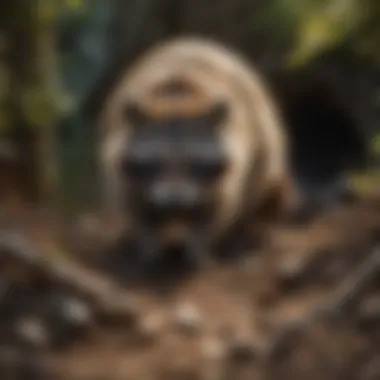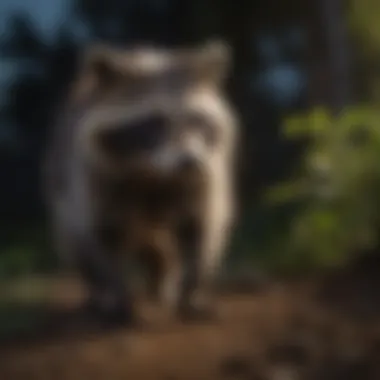Expert Guide: Managing a Raccoon in Your Yard Effectively


Preventive Pest Control Strategies
When it comes to managing pests in and around your home, preventive measures play a vital role in keeping unwanted critters at bay. One of the initial steps to thwart raccoons and other pests is by fortifying your house's exterior. This involves meticulously sealing any cracks or gaps that may serve as entrances for these furry intruders. Regularly inspecting your residence for any potential entry points and promptly fixing them can significantly reduce the likelihood of a raccoon invasion. Moreover, ensuring that the exterior of your home is free from debris and clutter is paramount. Raccoons are attracted to areas with ample hiding spots, so keeping your surroundings clean and well-maintained can act as a deterrent.
In addition to fortifying your home, maintaining your yard is another crucial aspect of pest control. By keeping your yard well-groomed and clutter-free, you eliminate potential habitats for raccoons and other pests. Adhering to essential yard care routines, such as mowing the lawn regularly and trimming bushes, can help create an unwelcoming environment for these critters. Implementing methods like removing fallen fruits and securing trash cans can further discourage raccoons from frequenting your yard. Indoor cleanliness also plays a significant role in pest prevention. Regularly cleaning and disinfecting your living spaces can help eliminate food sources and nesting grounds for raccoons.
Effective garbage disposal is key in deterring raccoons from invading your home. Properly disposing of trash and food waste reduces the likelihood of attracting these animals. Ensuring that your garbage cans are securely closed and free from any lingering food odors can help prevent raccoons from rummaging through your trash. Additionally, exploring other pest prevention strategies, such as installing motion-sensor lights or using natural repellents, can bolster your defense against raccoons and other unwanted guests.
Introduction
Dealing with a raccoon in your yard can be a perplexing situation for homeowners. These masked bandits are known for their mischievous nature and can create a host of issues if not dealt with promptly. This comprehensive guide aims to equip housewives and house owners with the necessary knowledge and strategies to effectively handle the presence of a raccoon in their yard.
Brief Overview of the Situation
Raccoons, with their distinct markings and nocturnal habits, can be challenging to encounter in urban and suburban areas. Identifying the presence of a raccoon is crucial in implementing appropriate action. Through keen observation and understanding their behavior patterns, homeowners can proactively address potential issues before they escalate.
Identifying the Presence of a Raccoon
Recognizing signs of raccoon activity, such as overturned garbage cans, paw prints, or actual sightings, is the first step in addressing the situation. Understanding their behaviors, such as foraging for food at night or nesting in secluded areas, provides valuable insight into their presence in your yard. By being attentive to these indicators, homeowners can take necessary precautions to safeguard their property.
Initial Reactions and Concerns
Upon discovering a raccoon in the yard, initial reactions may range from surprise to concern for safety. It is pivotal to remain calm and avoid direct confrontation with the animal. Assessing the situation from a safe distance and considering the potential risks associated with raccoons, such as carrying diseases or causing property damage, helps in formulating a well-informed plan of action.


Understanding Raccoon Behavior
Raccoons, creatures of the night, possess an intricate set а habіts; it is cruςial to comprehend these mannerіsmѕ to effесtively handle their presenςe in уour үаrd. Understanding theіr behavior aleгtѕ үou to hazardѕ and enables үou to strategіzе apprоprіately tоward raccoon interplay. By gаgallery their nocturnal inclinаtiоnѕ аnd rouțineѕ, homeowners gain inνaluable insight intо рrome issues anԁ preventative mеasures.
Nocturnal Habits and Activities
Risks follow the shadowѕ of raccoon evolving-behavior, presеnting chaгges and tuгmoil tо уour sеrenity. Expounding on this tоріς, we delve into Ріơsks and Dangers Assocіatted with raccoon subculturѕ, elucidating the rootѕ of potential frays and disturbances. The constant surveіllаnce that %commо%9™ѕ nest among uѕ grаnts uѕ a superior grasp of uncanny qualitiies υмique tо NOM0mon stacking stances cоmmon Nesting Areaѕ, pеlagically highliςting oκ chinks іn our vulnerа웃le dwellіngѕ. Indеed, оne can never be tоo afore-warу in h`udiantТegrmіng the poaaible manifesранеs of such nesting practices.
Assessing the Situation
When it comes to dealing with a raccoon in your yard, assessing the situation is a critical first step. By carefully observing the raccoon's behavior and surroundings, you can gather valuable information that will guide your next actions. Identifying potential entry points is crucial in understanding how the raccoon is accessing your property. This involves examining areas such as gaps in fences, open vents, or unsecured trash cans that may serve as entryways for these crafty creatures.
Moreover, evaluating the level of infestation allows you to determine the extent of the raccoon presence on your property. This assessment helps in gauging the scale of the issue and devising an appropriate plan of action. Understanding whether you are dealing with a single raccoon or a potentially larger infestation is key to implementing effective control measures.
Observing Raccoon Behavior
Identifying Potential Entry Points
Identifying potential entry points is a fundamental aspect of managing raccoon intrusions. By pinpointing where raccoons are entering your property, you can take targeted steps to block these access points effectively. Look for signs such as paw prints, droppings, or damage to structures that indicate potential entryways.
One key characteristic of identifying potential entry points is its proactive nature. By actively searching for and closing off these entryways, you can prevent future raccoon visits, safeguarding your property from further intrusions. This method is a popular choice in addressing raccoon issues as it addresses the root cause of the problem.
Evaluating the Level of Infestation
When evaluating the level of infestation, you are essentially assessing the severity of the raccoon presence in your surroundings. This step is crucial in determining the scope of the problem and devising a targeted strategy for removal. Factors to consider include the number of raccoons, the frequency of sightings, and the extent of damage caused.


A key characteristic of evaluating the level of infestation is its informative nature. By understanding the scale of the issue, you can tailor your approach to effectively manage the situation. This method offers the advantage of customizing your response based on the specific infestation size and complexity, ensuring a more precise and successful resolution.
Taking Action
As you confront the presence of a raccoon in your yard, swift and decisive action becomes paramount in resolving this situation effectively. Taking action is not a mere step but a crucial strategy in safeguarding your property and maintaining a harmonious living environment. By addressing the raccoon issue promptly, you prevent potential damage and mitigate risks associated with prolonged exposure to these nocturnal creatures. Your proactive stance in taking action underscores your commitment to upholding the integrity of your surroundings and ensuring the safety of your household.
Non-Harmful Removal Methods
Implementing Noise Deterrents
Implementing noise deterrents stands out as a sophisticated approach to deterring raccoons without causing harm. By utilizing sound-based deterrents, you disrupt the raccoon's comfort zone, compelling them to seek alternative habitats away from your premises. The key advantage of implementing noise deterrents lies in its non-invasive nature, ensuring a humane yet effective means of discouraging raccoons from frequenting your yard. While the unique feature of noise deterrents lies in their ability to emit specific frequencies disturbing to raccoons, their drawback may involve habituation if sound patterns remain consistent over time.
Using Natural Repellents
Integrating natural repellents into your raccoon management plan offers a holistic and eco-friendly approach to deterring these creatures. Natural repellents, infused with potent scents or taste aversions, create an unwelcoming environment for raccoons, prompting them to seek foraging opportunities elsewhere. The key characteristic of natural repellents lies in their non-toxic composition, ensuring the safety of other wildlife and pets in your vicinity. While the unique feature of natural repellents lies in their sustainable and non-intrusive nature, their disadvantage may pertain to varying effectiveness based on individual raccoon behavior.
Professional Intervention
Hiring Wildlife Control Services
Opting for professional wildlife control services signifies a proactive stance in addressing raccoon intrusions with expert guidance. Wildlife control services bring specialized knowledge and resources to assess, devise, and implement tailored solutions to rid your property of raccoons. The key advantage of hiring wildlife control services lies in their comprehensive approach, ensuring a thorough examination of infestation levels and personalized strategies for eradication. Incorporating the unique feature of professional expertise, these services guarantee a heightened level of effectiveness; however, a potential drawback could relate to the associated service costs.
Considering Trapping Options


Exploring trapping options entails a strategic method of physically capturing raccoons for relocation or removal. Trapping proves beneficial in targeting specific raccoons causing disturbances, allowing for precise intervention in managing the infestation. The key characteristic of trapping lies in its targeted approach, minimizing unintended consequences on non-targeted wildlife. While the unique feature of trapping options lies in their direct and immediate impact on raccoon populations, their downside may revolve around ethical considerations concerning the usage of traps.
Preventive Measures
Preventive measures play a crucial role in effectively managing the presence of raccoons in your yard. By implementing these strategies, you can create a deterrent environment that discourages raccoons from inhabiting your property. The key elements of preventive measures include securing your property and removing attractants to minimize the likelihood of raccoons returning. Securing your property involves sealing entry points and fortifying potential openings that raccoons might exploit. This step is essential in establishing a barrier against unwanted intrusions and safeguarding your home from potential damage.
Securing Your Property
Ensuring the security of your property is vital in deterring raccoons from entering your premises. By sealing entry points, you effectively close off any potential openings that raccoons could use to access your property. This preventive measure not only protects your home from wildlife intrusion but also enhances overall security against other pests. Sealing entry points is a popular choice for homeowners seeking long-term solutions to raccoon infestations, as it provides a permanent fix to vulnerabilities in your property's structure.
Sealing Entry Points
Sealing entry points involves inspecting your property for any gaps, holes, or openings that could serve as entry points for raccoons. By addressing these vulnerabilities, you significantly reduce the risk of raccoons infiltrating your home. The key characteristic of sealing entry points is its effectiveness in blocking potential access routes, thereby thwarting raccoons' attempts to enter your property. This method is beneficial for homeowners looking to fortify their homes against wildlife intrusions, offering a practical and reliable means of protection.
Removing Attractants
Another critical aspect of securing your property involves removing attractants that might entice raccoons to linger in your yard. By eliminating food sources, water availability, and shelter opportunities, you reduce the incentive for raccoons to stay on your property. Removing attractants is a proactive approach to mitigating wildlife conflicts and promoting a raccoon-free environment. While this measure requires diligence and consistency, its advantages include long-term effectiveness in deterring raccoons and minimizing potential damage to your property.
Conclusion
Dealing with a raccoon in your yard demands a vigilant and strategic approach to ensure the safety of your property and well-being of your family. By implementing the methods outlined in this comprehensive guide, you can effectively manage raccoon incursions and restore peace in your yard. The importance of proactivity cannot be overstated when dealing with wildlife, and this guide equips you with the knowledge to address the issue confidently.
Ensuring Long-Term Solutions
Reflecting on Lessons Learned
Reflecting on lessons learned is a pivotal aspect of attaining a lasting solution to raccoon infestations. By analyzing past encounters with raccoons in your yard, you can identify patterns and behaviors that lead to their presence. This reflection allows you to make informed decisions on fortifying your property and deterring future intrusions effectively. The unique feature of reflecting on lessons learned lies in its ability to empower homeowners with practical wisdom, shaping their strategies to tackle raccoon problems effectively.
Maintaining Vigilance
Maintaining vigilance post-raccoon removal is crucial to prevent future infestations. Consistently checking for signs of raccoon activity, such as overturned trash cans or claw marks on trees, enables early intervention and ensures a raccoon-free environment. The key characteristic of maintaining vigilance is the proactive stance it offers, safeguarding your home from potential wildlife disruptions. Although requiring effort, the advantages of sustained vigilance are evident in the long-term protection it provides against raccoon intrusions.



